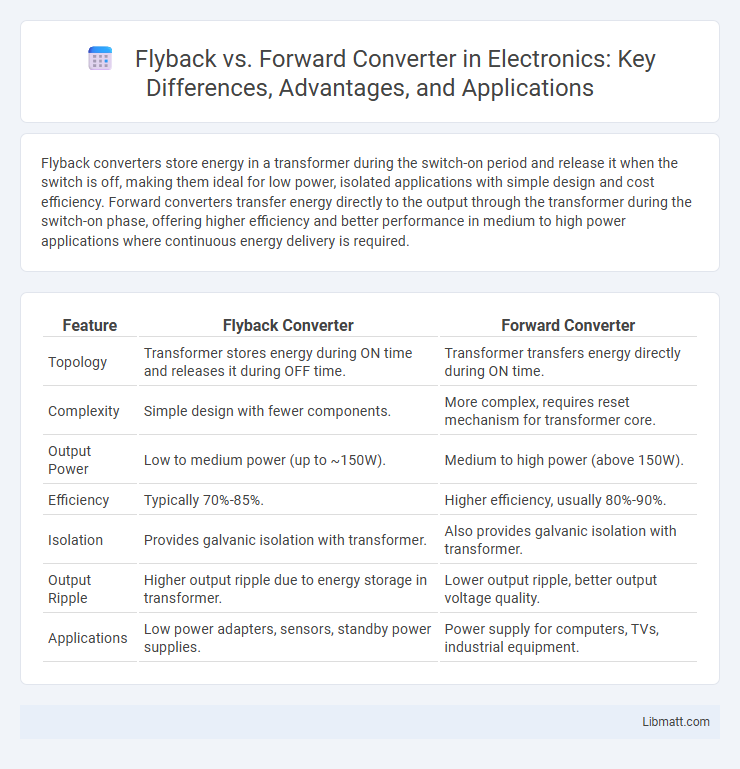Flyback converters store energy in a transformer during the switch-on period and release it when the switch is off, making them ideal for low power, isolated applications with simple design and cost efficiency. Forward converters transfer energy directly to the output through the transformer during the switch-on phase, offering higher efficiency and better performance in medium to high power applications where continuous energy delivery is required.
Table of Comparison
| Feature | Flyback Converter | Forward Converter |
|---|---|---|
| Topology | Transformer stores energy during ON time and releases it during OFF time. | Transformer transfers energy directly during ON time. |
| Complexity | Simple design with fewer components. | More complex, requires reset mechanism for transformer core. |
| Output Power | Low to medium power (up to ~150W). | Medium to high power (above 150W). |
| Efficiency | Typically 70%-85%. | Higher efficiency, usually 80%-90%. |
| Isolation | Provides galvanic isolation with transformer. | Also provides galvanic isolation with transformer. |
| Output Ripple | Higher output ripple due to energy storage in transformer. | Lower output ripple, better output voltage quality. |
| Applications | Low power adapters, sensors, standby power supplies. | Power supply for computers, TVs, industrial equipment. |
Introduction to Flyback and Forward Converters
Flyback converters store energy in a magnetic field within a transformer during the switch-on period and release it to the output during the switch-off time, making them ideal for low to medium power applications with isolated outputs. Forward converters transfer energy directly from input to output via a transformer during the on period of the switch, providing higher efficiency and better performance for medium to high power levels. Both topologies utilize transformers for isolation but differ in energy storage and transfer methods, impacting their suitability for various power supply designs.
Basic Operating Principles
Flyback converters store energy in a magnetic field during the switch-on phase and release it to the output during the switch-off phase, enabling efficient voltage conversion with electrical isolation. Forward converters transfer energy directly to the output through a transformer during the switch-on phase, providing better efficiency and continuous current flow. Understanding these basic operating principles helps you select the right converter for applications requiring isolated DC-DC voltage regulation.
Topology Comparison
Flyback converters utilize a single coupled inductor for energy storage and transfer, making them ideal for low-power applications with simpler topology and fewer components. Forward converters employ a transformer with separate windings for energy transfer, enabling higher efficiency and better voltage regulation suitable for medium to high power levels. Your choice depends on power requirements, isolation needs, and complexity preferences, with flyback favored for compact designs and forward for improved performance.
Efficiency Differences
Flyback converters typically exhibit lower efficiency compared to forward converters due to their energy storage and transfer method involving a transformer with a single switch and an energy storage inductor. Forward converters improve efficiency by allowing continuous energy transfer during the switch ON time, reducing the stress on components and minimizing energy loss in the transformer. Your choice should consider these efficiency differences, especially in applications requiring higher power levels or continuous operation.
Component Count and Cost
Flyback converters typically require fewer components than forward converters, resulting in lower overall cost and simpler circuit design due to the use of a single power switch and transformer winding. Forward converters demand additional components such as output inductors and multiple switches, which increase both the complexity and the total component cost. This difference makes flyback converters more cost-effective for low to medium power applications, while forward converters are better suited for higher power levels despite their higher component count and cost.
Voltage and Power Range Suitability
Flyback converters are ideal for low to medium power applications typically up to 150 watts and provide effective voltage isolation with simpler design requirements. Forward converters suit medium to high power ranges, from around 100 watts to several kilowatts, offering better efficiency and continuous energy transfer. Your choice depends on the voltage regulation needs and power capacity of your specific application.
Core Magnetization and Reset Methods
Flyback converters store energy in the transformer's magnetic core during the switch-on period, requiring a reset through the secondary winding or an auxiliary reset winding to prevent core saturation and ensure proper core magnetization. Forward converters transfer energy directly to the output during the switch-on time, using a dedicated reset winding or an external reset circuit to demagnetize the core and maintain continuous operation. Your choice between these topologies depends on factors like efficiency, component stress, and complexity associated with core magnetization and reset techniques.
Output Voltage Regulation
Flyback converters offer simpler output voltage regulation by using a single energy storage component and providing isolation through the transformer, which suits low to medium power applications with varying loads. Forward converters provide tighter output voltage regulation and higher efficiency at higher power levels due to their continuous energy transfer during the switching cycle and more complex design. Your choice between flyback and forward converters will depend on the required precision and stability of the output voltage in your application.
Applications and Use Cases
Flyback converters are widely used in low to medium power applications such as battery chargers, LED drivers, and small power supplies due to their simple design and cost-effectiveness. Forward converters are preferred for medium to high power applications including telecom power supplies, industrial equipment, and server power systems because of their efficiency and better voltage regulation. Both topologies serve distinct roles across power electronics, with flyback excelling in isolated, low-power scenarios and forward converters favored for higher power, continuous current requirements.
Choosing the Right Converter
Choosing the right converter depends on your power requirements and application complexity. Flyback converters are ideal for low to medium power levels up to around 150 watts, offering simplicity and cost-effectiveness with isolated output. Forward converters suit higher power applications, typically exceeding 150 watts, providing better efficiency and lower output noise for sensitive electronics.
Flyback vs Forward Converter Infographic

 libmatt.com
libmatt.com